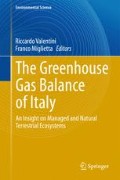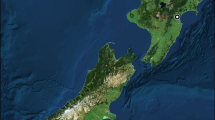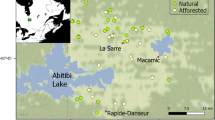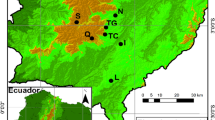Abstract
In the last decades, the European Union has favored the conversion of marginal croplands to forest plantations also to mitigate climate change by increasing carbon storage in the biosphere. In Italy, recent estimates report that forest plantations cover a total area of 122,252 ha. The aim of the present paper was to quantify carbon stock and annual carbon flux in mixed broadleaf and poplar plantation in Friuli Venezia Giulia plain. Overall, 2,592 ha of mixed broadleaf plantation (1992–2006) and 3,113 ha of poplar plantations (2002–2006) have been established in the Region with a standing carbon stock of 223,400 and 397,753 Mg C, respectively. Soil is the largest carbon pool in both plantation types (60 and 63 % of total ecosystem carbon stock). The total annual carbon sequestration is respectively 8,855 and 40,286 Mg C y−1 whereas soil accounts for 13 % in broadleaf plantations and 9 % in poplar plantations.
Similar content being viewed by others
Keywords
These keywords were added by machine and not by the authors. This process is experimental and the keywords may be updated as the learning algorithm improves.
1 Introduction
Since the origin of agriculture, human population and its consumption of resources have increased and forest and other natural areas have been gradually turned into farmlands, pasturelands and cities. In fact landscape is the result of an alternation of periods of forest expansion (i.e. succession) and periods of reduction in forest areas.
In the last decades, the European Union has supported the conversion of marginal croplands to forest plantations in order to achieve several targets: to diversify farmers’ income through high quality wood production in the plain, to support agricultural products’ prices by reducing cropland area; to diversify the landscape by restoring some natural elements; to mitigate climate change by increasing carbon storage in the biosphere. With reference to the latter aspect, the net carbon exchange in terrestrial ecosystems is the result of a delicate balance between uptake and emissions which show a diurnal, seasonal and annual variability. Consequently, small changes in the relative rates of carbon uptake through photosynthesis and/or carbon loss through respiration can have profound effects on the accumulation of CO2 in the atmosphere. The Kyoto protocol suggests that management of natural terrestrial carbon sinks, primarily afforestation and reforestation at a global scale, can increase the sink strength and reduce atmospheric CO2 concentration.
The terms used in this chapter refer to those adopted by the IPCC Guidelines (2000) which define afforestation as the “planting of new forests on lands which, historically, have not contained forests” and reforestation as “the establishment of trees on land that has been cleared of forest within the relatively recent past”. The distribution of sources and sinks of carbon over the land surface is dominated by changes in land use: in the tropics current rates of deforestation are responsible for a large loss of carbon; in the north mid-latitudes past changes in land use (i.e. natural forest recovery, forest plantations) can explain much of the observed carbon sink (Houghton and Hackler 2000; Pacala et al. 2001; Houghton 2003).
In Italy, recent estimates report that forest plantations cover a total area of 122,252 ha (54 % poplar plantations; 34 % mixed broadleaf plantations; 12 % coniferous plantations) (Gasparini and Tabacchi 2011). This area is only 1.4 % of total Italian forest area and covers only 0.4 % of country surface, but it has been increasing year by year in the last decades following new European Union regulations and incentives. Thus, the role of these plantations for carbon sequestration has become quite relevant (Magnani et al. 2005) as afforestation and reforestation do not only increase above-ground carbon stocks, but also restore and increase carbon into soil. At steady state, each soil has a theoretical equilibrium carbon content depending on the nature of vegetation, precipitation and temperature (Paul et al. 2002; Guo and Gifford 2002). This equilibrium is the result of the balance between inflows and outflows of the pool and can be disturbed by land use change until a new equilibrium is reached in the new ecosystem. During land use changes, soil can act as a source or a sink of carbon according to the ratio between inflows and outflows. Rodeghiero (2006) reports a carbon accumulation of 0.33 Mg C ha−1 y−1 following conversion of a cropland into a forest plantation. Guo and Gifford (2002), in their comprehensive meta-analysis, report an increase of 18 % in soil carbon stocks after cropland afforestation.
The Friuli Venezia Giulia Region, following the application of the measure 06 of the EU 2080/92 Regulation and the application the Rural Development Plan Rural 2000–2006 (measure h and i.1), encouraged the conversion of agricultural and non-agricultural lands into forest plantations.
The aim of the present study can be described as follows (i) to quantify total carbon stock and its partitioning among different ecosystem pools (i.e. aboveground, roots and soil) and (ii) to quantify annual carbon sequestration among these different pools both in mixed broadleaf and poplar plantations in the Friuli Venezia Giulia Region. To achieve these two objectives, a chronosequence approach was adopted.
2 Study Area and Data Analysis
The study area is the Friuli Venezia Giulia plain where climatic conditions are quite uniform (average annual temperature: 13.5 °C; average annual precipitation: 1,100–1,500 mm). However, depending on the substrate characteristics, this area can be divided into two sub-areas: the Northern part is characterized by a very permeable substrate made up of pebbles and gravel whose diameter decreases moving towards the valley; the Southern part is characterized by clay soils with an high water retention potential. In particular, this last area is quite suitable especially for poplar cultivation because of the high water requirements of this species.
The basic unit considered in this work coincided with individual land parcels or sets of contiguous parcels uniform in terms of stand characteristics (i.e. species composition, structure, age). This study considered mixed broadleaf plantations planted after 1992 with a rotation period of at least 20 years. Moreover, poplar plantations realized after 2002 with a rotation period of 8–10 years were also considered. On the basis of the data given by the Regional Forest Administration, a set of 36 mixed broadleaf plantations and 9 poplar plantations distributed across the plain and across different age classes was selected.
Within each stand, 5 points within a 50 × 50 m grid were randomly selected avoiding plantation’s edge. At each point, a 10 m radius plot (314 m2) was set up for dendrometric measurements. In each plot, all standing trees were recognized, numbered, diameters at breast height (DBH, 1.30 m) and total height were measured. Total aboveground carbon stock was determined according to specific allometric equations for broadleaf plantations (Alberti et al. 2006).
Instead, specific allometric equations elaborated by the Regional Forest Administration for poplar were used. Root biomass was derived using a root/shoot ratio of 0.26 (IPCC 2003).
Aboveground NPP (Mg ha−1 y−1) was modeled assuming a logistic growth model. In particular, it was considered equal to the first derivative of Richard’s logistic model (Cooper 1983; Hooker and Compton 2003):
where Bmax is the maximum aboveground carbon stock (Mg C ha−1), t is stand age (years), a and b are fitting parameters.
For the mixed broadleaf plantations, a subsample of six stands distributed in two age classes (10 and 20 years) were considered for soil carbon stock assessment. Instead, in the case of poplar plantation, all previously nine selected stands were considered (3, 6 and 9 years). Moreover, adjacent cropland (i.e. maize and wheat for mixed broadleaf and poplar plantations, respectively) were also included in the analysis. Within each forest stand or agricultural crop, five points were randomly selected. Then eight soil cores around each point were collected at two depths (0–15 and 15–30 cm) after litter removal. Prior to processing, samples were kept at 4 °C. Each sample was mixed and sieved through a 2-mm sieve and then dried at 102 °C for 48 h. Dried material was ground to a fine powder, treated with HCl 2:1 to remove carbonates and then analyzed for organic C and N using a CHN Elemental Analyzer. Soil bulk density for each depth was estimated at each selected point following the excavation method (Elliott et al. 1999). Measured values were then plotted against aboveground carbon stocks and linear regressions were used to quantify soil carbon stocks and soil carbon stock changes at different stand ages.
3 Results for the Friuli Venezia Giulia Case Study
By using the data provided by the Regional Forest Administration, it was possible to determine the annual cropland surface converted to mixed broadleaf and poplar plantations (Fig. 13.1). In this last case, only plantations realized after 2002 were considered as at the end of the rotation period (8–10 years) the stand is usually clear-cut. Thus, our carbon budget considered the normal rotation period length for both plantation types. The annual conversion rate was between 3 and 532 ha−1 y−1 and between 238 and 606 ha y−1 for mixed broadleaf and poplar plantations, respectively. Overall 2,592 ha of mixed broadleaf plantation (1992–2006) and 3,113 ha of poplar plantations (2002–2006) have been established in the Region.
The average density per hectare in mixed broadleaf plantations was equal to 1,690 ± 29 stumps ha−1. The species composition was quite varied although there was a prevalence of common ash (Fraxinus excelsior L.), cherry (Prunus avium L.), maple (Acer campestre L.) and oak (Quercus robur L.). Aboveground carbon stock (stems and branches) in the selected plantations ranged from 1.5 to 37.3 Mg C ha−1 at 3 and 23 years, respectively.
Modeled aboveground carbon stock grew asymptotically with stand age, and a good correlation between modeled and measured values was found (Fig. 13.2a). On average, mean aboveground carbon stock was 25.3 Mg C ha−1 (Table 13.1). According to the model, maximum aboveground NPP is reached at 9–10 years (3.4 Mg C ha−1 y−1) and then it gradually decreases to 0.4 Mg C ha−1 y−1 at 23 years. Aboveground productivity is therefore rather high even though maximum NPP is reached quite early probably because of the high stand density and the absence of thinnings. Magnani et al. (2005) reported an aboveground NPP of 1.8 Mg C ha−1 y−1 for a 12 year old plantation. The same authors showed that maximum NEE was reached at 9–10 years. In our plantation, at the same age aboveground NPP was 2.7 Mg C ha−1 y−1. Considering all the realized plantations (1992–2006), mean annual aboveground NPP is 2.4 Mg C ha−1 y−1, a value lower than 4.3 Mg C ha−1 y−1 estimated by Anderle et al. (2002).
Modeled aboveground carbon stock across the broadleaf plantation chronosequence (a) and poplar chronosequence (b) as a function of stand age. Dots represent measured data, continuous line represents modeled data. Vertical bars are standard errors. Correlation between modeled and measured data is reported in the inserted panel with 95 % confidence intervals (broadleaf: Y = 0.99 X + 0.026, R2 = 0.97, p < 0.001, intercept is not significantly different from zero; poplar: Y = 0.96 X + 2.73, R2 = 0.99, p = 0.004, intercept is not significantly different from zero)
The average density per hectare in poplar plantations was around 204 stems ha−1. Aboveground carbon stock ranged between 2.7 and 56.1 Mg C ha−1 in 3 and 9 year old stands, respectively. A good agreement between measured values and values reported by the yield table for Veneto (Famiglietti 1968) was found (Fig. 13.2b). Aboveground NPP, derived from the yield table, was between 0.9 and 12.0 Mg C ha−1 y−1, underlying the very high productivity of this species.
A good correlation between soil carbon and aboveground carbon stocks was found in both chronosequences (Table 13.2). Soil carbon stock ranged between 49.8 and 56.9 Mg C ha−1 at 0 and 30 years in mixed broadleaf plantations and between 68.6 and 79.8 Mg C ha−1 at 0 and 10 years for poplar plantations. It can be estimated that this pool represents 53 and 48 % of total ecosystem carbon stock at the end of the rotation period (Fig. 13.3). Considering all the area covered by such forest plantations, mean soil carbon stock changes were 0.4 and 1.1 Mg C ha−1 y−1 (13 and 9 % of total annual carbon sequestration) for mixed broadleaf and poplar plantations, respectively.
Mean annual soil carbon sequestration measured in this study is between the values reported by Rodeghiero (2006) (0.33 Mg C ha−1 y−1) and by Bouwman and Leemans (1995) (1.6 Mg C ha−1 y−1). Moreover, final soil carbon stock change (+14, +16 %) estimated at the end of the rotation period (30 and 10 years for mixed broadleaf and poplar plantations, respectively) is well within the range reported by Guo and Gifford (2002) in their comprehensive review (+18 %).
4 Conclusions
Overall, mixed broadleaf and poplar plantations in Friuli Venezia Giulia have a standing carbon stock of 223,400 and 397,753 Mg C, respectively. Soil is the largest carbon pool in both plantation types (60 and 63 % of total ecosystem carbon stock, respectively). Total annual carbon sequestration is 8,855 and 40,286 Mg C y−1 with soil contributing for 13 and 9 % in broadleaf and poplar plantation, respectively.
These results highlight the importance of forest plantations for carbon sequestration at regional level. However, it should be noted that maximum NPP is reached quite early in the absence of an adequate management (i.e. thinnings). However, our data suggest that short rotation period (less than 12 years) can maximize the carbon sequestration potential of both mixed broadleaf and poplar plantations.
References
Alberti G, Marelli A, Piovesana D, Peressotti A, Zerbi G, Gottardo E, Bidese F (2006) Accumulo di carbonio e produttività delle piantagioni legnose (Kyoto forests) del Friuli Venezia Giulia. Forest@ 3(4):488–495
Anderle A, Ciccarese L, Dal Bon D, Pettenella D, Zanolini E (2002) Assorbimento e fissazione del carbonio nelle foreste e nei prodotti legnosi in Italia. Rapporto 21/2002 APAT, Roma p 58
Bouwman AF, Leemans R (1995) The role of forest soil in the global carbon cycle. Soil Sci Soc Am 503–525
Cooper CF (1983) Carbon storage in managed forests. Can J For Res 13:155–166
Elliott ET, Heil JW, Kelly EF, Monger HC (1999) Soil structural and other physical properties. In: Robertson GP, Coleman DC, Bledsoe CS, Sollins P (eds) Standard soil methods for long-term ecological research. Oxford University Press, Oxford, pp 74–85
Famiglietti A (1968) Tavola alsometrica del pioppo per il Veneto. In: Castellani C (ed) Tavole stereometriche ed alsometriche costruite per i boschi Italiani. Istituto Sperimentale per l’Assestamento Forestale e per l’Alpicoltura: 693
Gasparini P, Tabacchi G. (a cura di) (2011) L’Inventario Nazionale delle Foreste e dei serbatoi forestali di Carbonio INFC 2005. Secondo inventario forestale nazionale italiano. Metodi e risultati. Ministero delle Politiche Agricole, Alimentari e Forestali; Corpo Forestale dello Stato. Consiglio per la Ricerca e la Sperimentazione in Agricoltura, Unità di ricerca per il Monitoraggio e la Pianificazione Forestale. Edagricole-Il Sole 24 ore, Bologna. pp 653
Guo LB, Gifford RM (2002) Soil carbon stocks and land use change: a meta analysis. Glob Change Biol 8(4):345–360
Hooker TD, Compton JE (2003) Forest ecosystem carbon and nitrogen accumulation during the first century after agricultural abandonment. Ecol Appl 13(2):299–313
Houghton RA (2003) Why are estimates of the terrestrial carbon balance so different. Glob Change Biol 9(4):500–509
Houghton RA, Hackler JL (2000) Changes in terrestrial carbon storage in the United States. I: the roles of agriculture and forestry. Glob Ecol Biogeogr 9(2):125–144
IPCC (2000) In: Watson RT, Noble IR, Bolin B, Ravindranath NH, Verardo DJ, Dokken DJ (eds) Land use, land-use change and forestry. Cambridge University Press, Cambridge, p 375
IPCC (2003) Penman J, Gytarsky M, Hiraishi T, Krug T, Kruger D, Pipatti R, Buendia L, Miwa K, Ngara T, Tanabe K, Wagner F, Good Practice Guidance for Land Use, land-Use Change and Forestry IPCC/IGES, Hayama, Japan
Magnani F, Grassi G, Tonon G, Cantoni L, Ponti F, Vicinelli E, Boldreghini P, Nardino M, Georgiadis T, Facini O, Rossi F (2005) Quale ruolo per l’arboricoltura da legno italiana nel protocollo di Kyoto? Indicazioni da una “Kyoto foret” della pianura emiliana. Forest@ 2(4):333–344
Pacala SW, Hurtt GC, Baker D, Peylin P, Houghton RA, Birdsey RA, Heath L, Sundquist ET, Stallard RF, Ciais P, Moorcroft P, Caspersen JP, Shevliakova E, Moore B, Kohlmaier G, Holland E, Gloor M, Harmon ME, Fan SM, Sarmiento JL, Goodale CL, Schimel D, Field CB (2001) Consistent land-and atmosphere-based US carbon sink estimates. Science 292(5525):2316–2320
Paul KI, Polglase PJ, Nyakuengama JG, Khanna PK (2002) Change in soil carbon following afforestation. For Ecol Manag 168:241–257
Rodeghiero M (2006) Metodologie per la stima del carbonio nei suoli forestali. In: Pilli R, Anfodillo T, Dalla Valle E (eds) Stima del Carbonio in foresta: metodologie ed aspetti normativi, Pubblicazione del Corso di Cultura in Ecologia, Atti del 42°corso, Università di Padova, pp 141–159
Acknowledgments
The authors would like to thank Diego Chiabà and Gabriele Pingitore for the help in the data collection and lab analysis.
Author information
Authors and Affiliations
Corresponding author
Editor information
Editors and Affiliations
Rights and permissions
Copyright information
© 2015 Springer-Verlag Berlin Heidelberg
About this chapter
Cite this chapter
Alberti, G., Vedove, G.D., Stefanelli, S., Vanone, G. (2015). Afforestation and Reforestation: The Friuli Venezia Giulia Case Study. In: Valentini, R., Miglietta, F. (eds) The Greenhouse Gas Balance of Italy. Environmental Science and Engineering(). Springer, Berlin, Heidelberg. https://doi.org/10.1007/978-3-642-32424-6_13
Download citation
DOI: https://doi.org/10.1007/978-3-642-32424-6_13
Published:
Publisher Name: Springer, Berlin, Heidelberg
Print ISBN: 978-3-642-32423-9
Online ISBN: 978-3-642-32424-6
eBook Packages: Earth and Environmental ScienceEarth and Environmental Science (R0)







